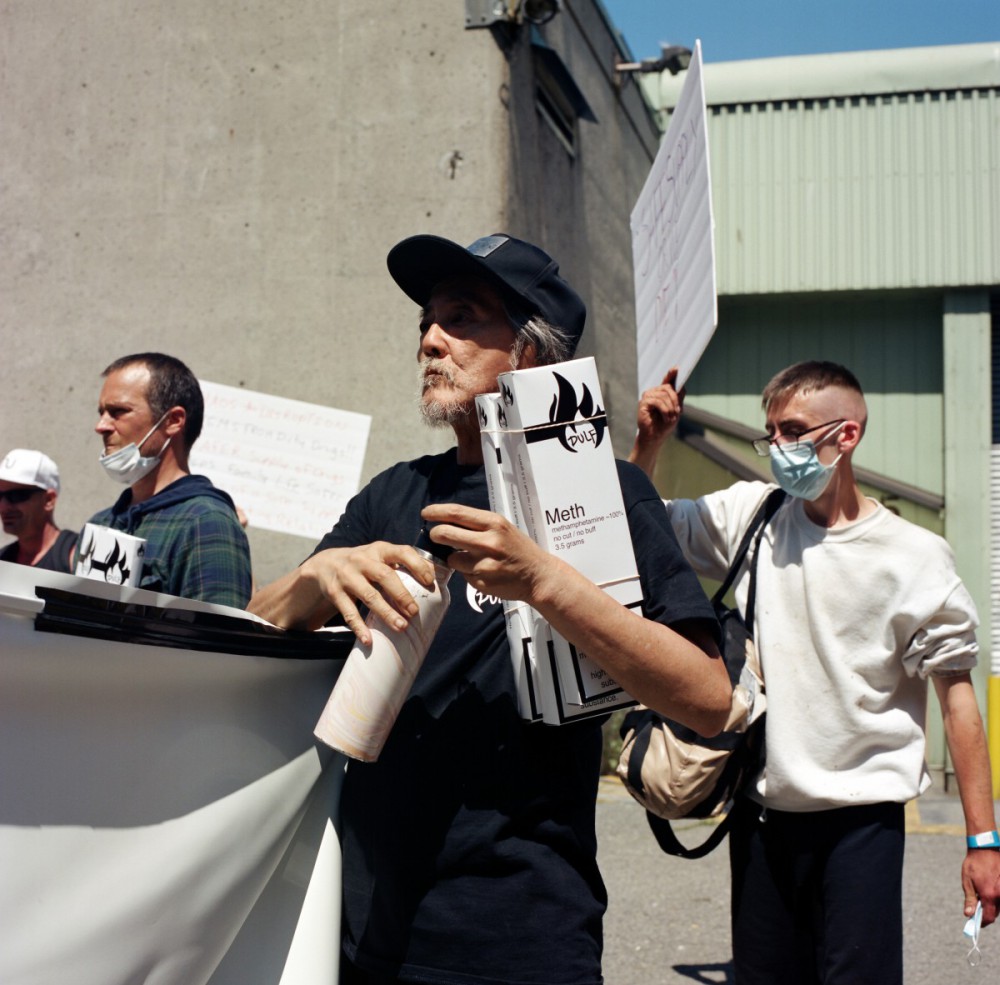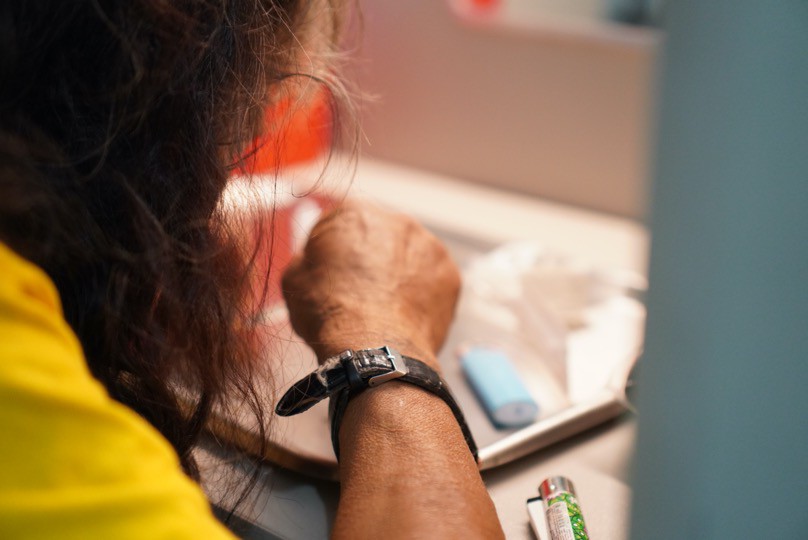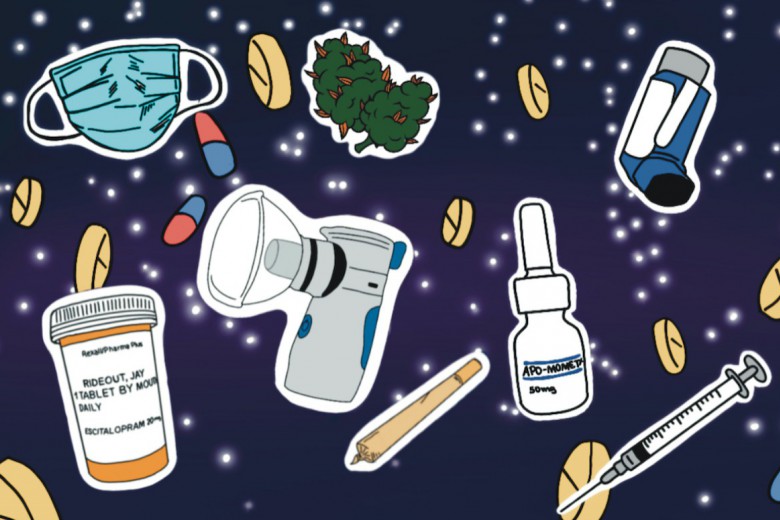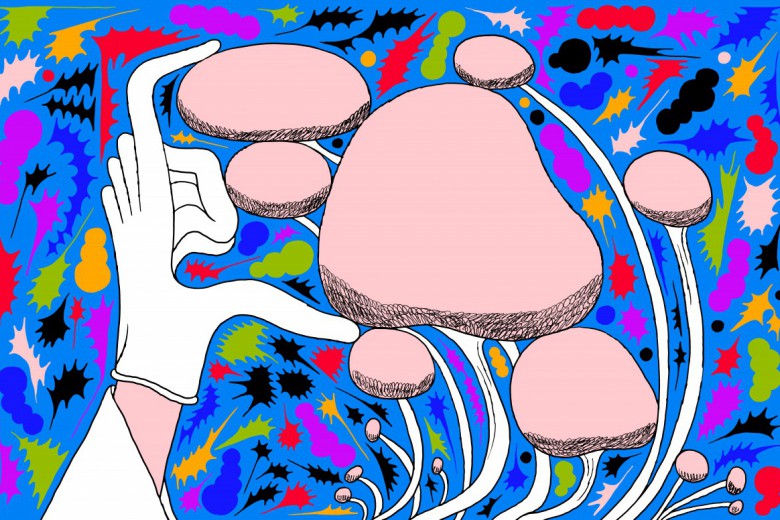On February 9, the Drug User Liberation Front (DULF), the Vancouver Area Network of Drug Users (VANDU), and the B.C. Association of People on Opiate Maintenance (BCAPOM) organized a drug giveaway in Vancouver’s Downtown Eastside. I arrived, about an hour before the event started, to find a couple of people sleeping on a couch and others busy taking names and arranging chairs. A counter where drug users could access harm reduction supplies and talk with peer counsellors split the room in two, and a hallway in the back led to VANDU’s safe consumption site.
Regulars arrived and hung around outside, smoking on the sidewalk and talking. Then the media started to trickle in: independent journalists with compact cameras, big networks with bulky recorders and tripods, everyone masked. At 1:30, sign-up began: people already accessing opiate substitution put their name on the list to receive measured, tested doses of heroin, methamphetamine, and cocaine. Sign-up didn’t last long – there was so much interest that the organizers had to lock the door, however briefly.
Just hours before the drug giveaway, the B.C. Coroners Service had announced that 2,224 people had died from opiate overdoses in B.C. in 2021. That number has risen by more than 400 per cent over the past seven years, as illicit drugs have increasingly been poisoned by deadly fentanyl, carfentanil, and now etizolam (benzos).
In a way, I thought, that’s the whole point: access to a regulated supply of narcotics shouldn’t be a media event, but rather a run-of-the-mill part of daily life.
One by one, drug user activists gave chilling speeches about the risks they take and the dangers they face in trying to to stay alive. They talked about the many who had died: their friends, their family members, their fellow organizers. They decried the provincial and federal governments’ lack of action. And they outlined their model for change: an exemption under Section 56 of Health Canada’s Controlled Drugs and Substances Act that would allow them to set up a compassion club, through which drug users could become members and access substances that are tested and safe.
When the speeches were done, we stood for a minute of silence. As soon as the last second passed, the media rushed a small table at the back of the room, ready to shoot the giveaway. It was a strange anti-climax: few things are more boring than watching someone pick up a prescription. In a way, I thought, that’s the whole point: access to a regulated supply of narcotics shouldn’t be a media event, but rather a run-of-the-mill part of daily life.
After the drugs were handed out – two boxes with a tenth of a gram each to 15 people – I spoke with Nikki, who had received a dose of meth and another of cocaine. “I mean, I’m in a wheelchair because I did a shot and I went unconscious in my room for 72 hours, and rats bit me for 72 hours on my legs,” she said. “And that was just from doing a shot. So I didn’t know what was in the shot.” She said that, for her safety, she’s since moved to using drugs in public places – but what would really make her safer is access to a tested supply.
Later, I talked to Al Fowler, who has lived in Vancouver’s Downtown Eastside for decades. I asked him how his life would be different if he could access a safe supply. “Well, I wouldn’t be going down to Main and Hastings to score, you know,” he said. “I’ve died twice. Standing up with my boots on […] I was standing on the corner, dead.” After decades of drug use, both of Fowler’s overdoses took place in the last year.
The call for a safe supply, coming from drug user activists in Canada, is a brave intervention that could have far-reaching consequences – first, in stopping deadly overdoses, but also in ending the harms of militarized prohibition in the South.
I’ve spent much of the last 10 years reporting on the fallout of the war on drugs in Mexico. Since 2006, over 350,000 people have been killed in Mexico, and the same number displaced by the conflict. Nearly 100,000 people have been disappeared, their family members leading searches in the face of government inaction. These harms are caused largely due to a strategy of militarization via the army, the National Guard, and dozens of state-level police forces, under the pretext of controlling the production and shipment of narcotics from Mexico to the U.S. and Canada.
The call for a safe supply, coming from drug user activists in Canada, is a brave intervention that could have far-reaching consequences – first, in stopping deadly overdoses, but also in ending the harms of militarized prohibition in the South. I wanted to fit these two pieces together: drug user activism in Vancouver, where I grew up, and the work being done to end prohibition in Mexico, where I live, and even further south.
At a protest in Vancouver on July 14, 2021, a member of the Vancouver Area Network of Drug Users holds boxes of safe and tested methamphetamine. Photo by Jackie Dives.
In the South, harm reduction means demilitarizing
“A big part of harm and risk reduction has been concentrated on the consumption of narcotics,” says Amaya Ordorika. “But at ReverdeSer, we work from a perspective that we call full-spectrum harm and risk reduction by and for the Global South.”
I’m speaking to Ordorika by phone – she’s in Mexico City, where she works as ReverdeSer’s political advocacy coordinator. ReverdeSer is a youth-led organization dedicated to promoting the regulation of narcotics. Ordorika and her colleagues do drug testing and education, provide material support for family members of victims of violence related to the drug war, and push for the regulation of narcotics in Mexico.
She tells me how in the South, drug prohibition criminalizes users, but it is primarily focused on using state forces to control the production and northward transport of narcotics. In Mexico, the struggle against the drug war includes organizing against the criminalization of rural communities dedicated to farming opium and marijuana, organizing against the intensification of border control and restrictions on freedom of movement, and pushing back on military, police, and paramilitary actions that are key drivers of violence and violations.
“Our struggle is connected to both poles of the illicit market, which are also the most vulnerable: people who use drugs and the campesinos who produce them.”
In broad strokes, ReverdeSer’s vision of harm reduction in the South means not only ensuring people are able to consume substances in a safe way, but also mitigating the risks to the population at large, as well as to folks entwined in illicit economies in myriad ways. Opium poppy growers in Mexico, for example, face extortion, torture, detention, and various other abuses at the hands of state security forces and paramilitary groups.
“Here, the regulation of the opium market would be something that would protect campesino farmers,” says Ordorika. It is widely believed that if opium farmers could sell their crops legally, the power of criminal organizations and the armed forces would lessen, reducing violence. Mexico’s hospital system has long had a shortage of morphine and other opium-derived pain treatments, which could be met through regulated production. Legislators in Guerrero state, Mexico’s largest producer of opium, presented a bill proposing the legalization of opium for medical use in 2018. It stalled in the Mexican senate.
I reach Ernesto Cortés, from the Latin American Network of People who use Drugs (LANPUD), at his home in San José, Costa Rica. He echoes Ordorika’s vision of harm reduction in the South. Cortés’s brother is currently three-and-a-half years into an eight-year sentence, accused of selling marijuana.
“For us, it’s not just about reducing the harms caused by substance use, it’s also about reducing the harms produced by prohibition and the illicit drug market,” says Cortés. He says drug users in Costa Rica face stigma from all public institutions, but especially from the police. “Our struggle is connected to both poles of the illicit market, which are also the most vulnerable: people who use drugs and the campesinos who produce them.”
"If I have 100 grams of marijuana, but I’m white, I’m considered a consumer,” says Comis. “But a Black person on the outskirts of the city with two joints? They’re considered a trafficker.”
Further south, in Brazil, drug users similarly face extreme stigma and police violence. “In areas where there is open drug use, the police don’t respect anyone, neither outreach workers nor drug users,” says Maria Angélica Comis, who is the coordinator of the É de Lei drop-in centre in downtown São Paulo. “It’s a very hostile environment, in which Black people, poor people, and trans people are heavily discriminated against, they are stigmatized, and they are considered to be traffickers.”
After we hang up, Comis sends me a video shot in central São Paulo the day after the DULF giveaway in Vancouver. In it, three different police forces carried out a street raid in which they forced hundreds of people, many of them drug users, to sit one beside another on the pavement for hours on end. People sat with their plastic bags, their belongings, there’s even a guy with a shopping cart. Whenever they tried to stand up or to move, the police fired rubber bullets. Twelve people were arrested.
According to Comis, Brazilian drug laws do not have objective criteria around possession, and it’s up to police to decide who is a trafficker and who is a consumer. “If I have 100 grams of marijuana, but I’m white, I’m considered a consumer,” says Comis. “But a Black person on the outskirts of the city with two joints? They’re considered a trafficker.”
Barriers to reducing risk for drug users
“Safe supply is the future,” says Jaime Arredondo Sánchez Lira, who works in harm reduction in the Mexican state of Baja California. “After 50 years of prohibition, we’re in the same place, but with fatal public health consequences, including a brutal increase of violence in Mexico, with thousands of murders and disappearances, and a terrible increase in deaths by overdose in North America,” he says by WhatsApp voice call from Tijuana.
Mexico’s northern border with the U.S. is one of a handful of places in Latin America where there is a high prevalence of injection drug use, as drugs move toward the United States. Arredondo has been instrumental in setting up La Sala – Latin America’s only safe consumption site – in Mexicali, a city that butts up against the border. Unfortunately, government support for harm reduction in Mexico has fallen off, even as many tout the leftist credentials of President Andrés Manuel López Obrador.
“Today we are living through one of the worst periods for people who use drugs, at least since I’ve been working here on the border,” says Arredondo, who is also Canada Research Chair in Substance Use and Health Policy Research at the University of Victoria. La Sala, which Arredondo calls an “unsanctioned place,” operates on risky terrain and could be shuttered by authorities at any moment.
The community centre that houses La Sala, a women-only safe consumption site in Mexicali, Mexico. Photo courtesy of Integración Social Verter A.C.
A woman uses La Sala’s safe consumption site in 2021. Photo courtesy of Integración Social Verter A.C.
La Sala is one of just four women-only safe consumption sites in the world. In 2019, it lost the $54,000 in annual funding it received from Mexico’s National Centre for the Prevention and Control of HIV and AIDS to buy harm reduction supplies, after the Mexican government slashed federal funding to non-governmental organizations. A GoFundMe has since been set up to keep La Sala open.
In Mexico, as in Argentina, Brazil, and elsewhere, naloxone, which can be used to reverse opiate overdoses, is not available through government programs. Being on the border means there is some access to naloxone in Mexicali, where Arredondo says La Sala sometimes receives donations from harm reduction activists and supporters in the U.S. and Canada who let them distribute the life- saving drug to community members. Fentanyl test strips are also hard to access and become increasingly rare the farther south of the U.S.-Mexico border you go.
Prohibition means there is no hard and fast data about which illicit substances are used the most in the region. According to Harm Reduction International, the majority of people who use illegal drugs in Latin America and the Caribbean use cannabis, followed by a much lower number of people who inhale or smoke cocaine, cocaine paste, or crack cocaine. Outside of parts of Mexico, Colombia, and Puerto Rico, there is little to no data regarding injection drug use, and it is considered rare.
In early February, 24 people died in Buenos Aires, Argentina, after using adulterated cocaine, putting drug overdoses on the front page of newspapers in a country where the use of narcotics is kept in the shadows. It took authorities nearly a week to confirm that it was in fact carfentanil that caused the overdoses, according to Mariano Fusero, a lawyer and president of RESET, an organization pushing for changes to drug policy in Argentina. The toxic cocaine was sold in a single, impoverished neighbourhood of the Argentine capital.
“It’s exceptional to have so many people die in such a short period of time,” says Fusero during a video call. “Those substances [fentanyl] don’t circulate as much here.”
“The difference between people who are street-involved in Canada or Europe, [and] a person who is on the street in Brazil, is that here, there’s no access to water; much less access to a safe supply.”
Outside of Mexicali, there are no safe consumption sites currently operating in Latin America. Comis says that her team would like to open up a safe consumption site in São Paulo, but they fear incarceration, and they can’t import the test kits they need to be able to analyze what people are inhaling to ensure it is safe. “We also know that such a space would be under heavy police surveillance,” she adds, which would make access risky for users and activists. In the meantime, workers with the É de Lei drop-in centre hand out mouth guards for pipes, alcohol wipes, and other paraphernalia to reduce risk.
But chief among the concerns of anti-poverty and harm reduction activists in São Paulo is ensuring an estimated 40,000 to 60,000 people living in the city’s streets have access to water. “We’re doing what’s necessary to ensure people’s survival, like fighting to make sure folks who live on the street have water to drink,” says Comis.
There’s no proper census of people who use drugs in São Paulo, which is Brazil’s largest city, but Comis estimates there are 1,500 people who use outdoors, on the streets, in three of the city’s central neighbourhoods. “The difference between people who are street-involved in Canada or Europe, [and] a person who is on the street in Brazil, is that here, there’s no access to water; much less access to a safe supply.”
A horizon of safe supply
“What DULF is doing, ostensibly, is taking out the fucking bottom Jenga blocks of the war on drugs, you know – so nobody wants to talk to us or even act like we exist,” says Eris Nyx of the Drug User Liberation Front. As we talk, a crane lifts an outhouse up to the roof of a partially built apartment building, a sign of the gentrification transforming Vancouver’s Downtown Eastside. Nyx says the City of Vancouver’s focus on harm reduction gives drug user activists some protection – it is one of the key components of the city’s “four pillars drug strategy.” “If they arrest us, we’ll take them to court,” Nyx continues. “If they don’t arrest us, we’ll just keep doing it and try and scale it as large as we can.”
Nyx tells me city staff involved in harm reduction activities privately praise DULF’s work but shy away from public support of activities like the drug giveaway, even when such actions save lives. A March 9 report from the B.C. Coroners Service, which calls on the province to “create a provincial framework for safer supply distribution” could represent a step in the right direction.
Vancouver City Councillor Jean Swanson, a long-time advocate for safe drug supply, participated in an event on July 14, 2021 where she handed out safe and tested heroin, cocaine, and methamphetamine to drug users in Vancouver’s Downtown Eastside. Photo by Jackie Dives.
I ask Nyx if she knows of other places where drug giveaways are being organized. “We’re the only people that do it. In the entire world,” she says. “I think Vancouver is the only place you could do it, though.”
Cortés, from Costa Rica, agrees. I ask him what would happen if he were to stage a drug giveaway in San José, and he answers with one word: jail. He says members of LANPUD in some countries, especially in Central America, are completely anonymous, unable to admit they use illicit substances for fear of state reprisal. To date, few countries in Latin America and the Caribbean have legalized cannabis for those without a prescription.
Even so, Cortés says his sights are set on regulation of all narcotics by governments across the hemisphere, similar to how other consumer products are regulated today. “We’re pushing for regulation, the legal regulation of all narcotics. That’s our horizon, but I think I’m going to die before that happens.”
During our call, I ask Fusero, the lawyer-activist in Buenos Aires, how he perceives the call for a safe supply. “We don’t talk about it in that way, we don’t call it ‘safe supply,’ but I like that,” he says. “We talk more about the regulation of the market, but our goal is the same.”
Safe supply seems distant in Mexico, too: there is no free access to safe treatment or substitutions (like methadone) for opiate users who want to stop taking chances on a poisoned drug supply. But that doesn’t mean Arredondo and other activists are going to stop dreaming.
“If you look at the downtown of the city of Tijuana, for example, there’s areas that look like the Downtown Eastside, just like it. There’s people using in the street and selling things,” he says. Arredondo is convinced there are opportunities for activists in Vancouver and Latin America to learn from each other. In fact, meetings between harm reductionists in B.C. and Baja California have already taken place.
“In the same way we were talking about safe consumption sites three to four years ago,” says Arredondo, “today we can start to talk about safe supply and put that idea on the table.”







